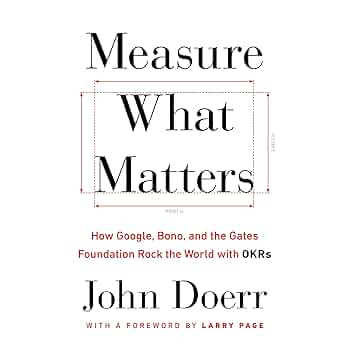In God we trust; all others must bring data.—W. Edwards Deming
The focus of this book is a management tool called OKRs (standing for Objectives and Key Results). Divided into different sections, with lots of real-life examples written by the actual people using this strategy to transform their projects, from Google to Bono, the book tries to make a case for why you should use them in your professional life.
OKRs are a management methodology that helps to ensure that the whole organization focuses its efforts on the same important issues. It's a way to make sure your team, your company, is moving in the right direction with a clear intention.
This comes as an alternative to the usual approach of “annual goal-setting”, usually resulting in objectives being lost in the middle of day-to-day operations and different emergencies happening throughout the year. In their daily work, people have conflicting priorities and blurring goals, usually arbitrarily made, contributing to higher levels of frustration and demotivation.
OKRs attempt to fight this by bringing a more balanced approach, trying to be “the yin and yang of goal-setting”, inviting principle and practice into action. If “Objectives” are “the stuff of inspiration”, “Key Results” are the metric-driven data allowing us to know if we achieve the goal or not. The KRs are specific, and time-bound, making them measurable and verifiable.
Whereas objectives can be long-lived, key results evolve as we move on. They demand flexibility harmonized with a meticulous focus on measurements. This combination allows companies to deal with crises, improving with them other than being destroyed or merely surviving.
Key Results can be seen as filters for reality, making us work on the things that matter, not distractions or sidetracks. Above everything else, the right output is what counts. Knowledge is great, but in a company, useless without a clear context or use. KRs provide focus and a clear action plan.
Embracing this framework brings with it the freedom to dare to dream bigger. Setting high standards and crazy goals is encouraged because you know, as long as they’re aligned with OKRs, no matter the actions you do, they’re contributing to the overall objective, moving the company forward.
Better outputs are a result of striving for what seems ungraspable, within an environment that’s designed to encourage agency.
A lot of people mistakenly assume that OKRs are “islands”, isolated amongst themselves. This is a major, yet common, mistake when using this framework. OKRs should be doing the opposite, creating networks among all parts of the company and creating a puzzle for the vision of the organization.
This brings changes in the culture and, of course, leadership.
One of the “complements” of OKRs is a feedback approach called CFR (Conversations, Feedback and Recognition). By bringing these 3 elements to the culture of your organization (as an alternative to “annual reviews), you’re allowing people to know their place in the organization and what they can do to improve it while feeling valued.
Overall, OKRs aim to help companies “out-behave” competitors.
Actions are the factor that makes the difference between companies and you can use OKRs to make sure that all actions are pushing your goals forward, generating drive within a team and creating alignment with its values and vision, allowing people to embrace self-organization.
As a company, you no longer depend on engagement from your team because you tap into something deeper: inspiration. Rules are abandoned, and shared principles are adopted. You design an environment where everything people do pushes you forward.
No stick or carrot but a common sense of purpose and trust.
That’s the ultimate goal of OKRs.




